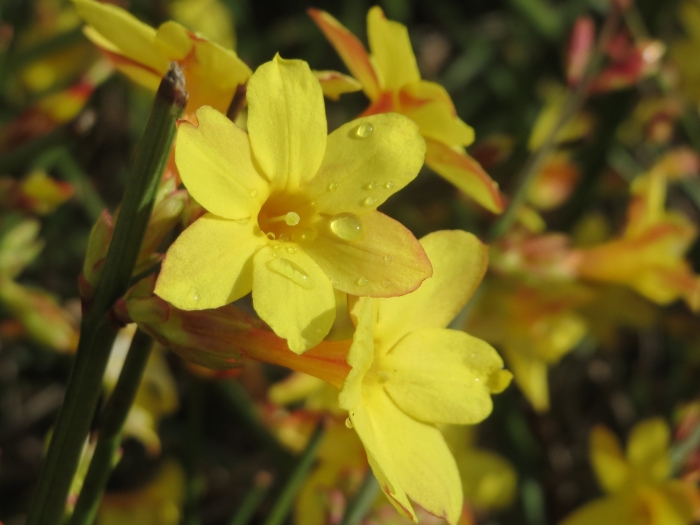Winter Jasmine
(Jasminum nudiflorum)
Winter Jasmine (Jasminum nudiflorum)
/
/

Andreas Rockstein
CC BY-SA 2.0
Image By:
Andreas Rockstein
Recorded By:
Copyright:
CC BY-SA 2.0
Copyright Notice:
Photo by: Andreas Rockstein | License Type: CC BY-SA 2.0 | License URL: https://creativecommons.org/licenses/by/2.0/ | Uploader: anro0002 | Publisher: Flickr |














































































Estimated Native Range
Summary
Jasminum nudiflorum, commonly known as Winter Jasmine, is a deciduous perennial vine native to woodland edges and scrubs in China. It typically grows to 3 m (10 ft) tall and wide, with slender, arching green shoots and opposite, pinnate, dark green leaves. Winter Jasmine is renowned for its bright yellow, non-fragrant flowers, about 1 cm across, which bloom from November to March, providing a splash of color during the winter months when few other plants are in flower. The flowers emerge on the bare stems before the leaves, hence the species epithet ’nudiflorum’ meaning ’naked flower’.
Winter Jasmine is valued for its winter flowering and is often used in gardens for wall training, providing extra warmth and shelter, or as a groundcover for its ability to spread and cover spaces. It is also appreciated for its ease of maintenance, including its tolerance for hard pruning, which should be done in spring immediately after flowering to maintain its shape and fullness. This plant is hardy and adaptable, thriving in full sun or partial shade, and can tolerate a range of soil types with different drainage speeds. It has received the Royal Horticultural Society’s Award of Garden Merit, indicating its excellence for garden use. Winter Jasmine can be propagated by layering and is also suitable for bonsai cultivation, tolerating wiring methods well. However, gardeners should be aware that it can spread vigorously and may require regular pruning to keep it in check.CC BY-SA 4.0
Winter Jasmine is valued for its winter flowering and is often used in gardens for wall training, providing extra warmth and shelter, or as a groundcover for its ability to spread and cover spaces. It is also appreciated for its ease of maintenance, including its tolerance for hard pruning, which should be done in spring immediately after flowering to maintain its shape and fullness. This plant is hardy and adaptable, thriving in full sun or partial shade, and can tolerate a range of soil types with different drainage speeds. It has received the Royal Horticultural Society’s Award of Garden Merit, indicating its excellence for garden use. Winter Jasmine can be propagated by layering and is also suitable for bonsai cultivation, tolerating wiring methods well. However, gardeners should be aware that it can spread vigorously and may require regular pruning to keep it in check.CC BY-SA 4.0
Plant Description
- Plant Type: Shrub, Vine
- Height: 10-15 feet
- Width: 3-6 feet
- Growth Rate: Moderate
- Flower Color: Yellow
- Flowering Season: Spring, Winter
- Leaf Retention: Deciduous
Growth Requirements
- Sun: Full Sun, Part Shade
- Water: Medium
- Drainage: Slow, Medium, Fast
Common Uses
Bank Stabilization, Bee Garden, Bird Garden, Butterfly Garden, Deer Resistant, Drought Tolerant, Erosion Control, Fragrant, Hummingbird Garden, Low Maintenance, Salt Tolerant, Showy Flowers, Street Planting
Natural Habitat
Woodland edges and scrubs in China, with bright yellow winter flowers
Other Names
Common Names: 영춘화
Scientific Names: , Jasminum nudiflorum, Jasminum nudiflorum var. aureum, Jasminum nudiflorum var. nudiflorum,
GBIF Accepted Name: Jasminum nudiflorum Lindl.